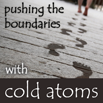Speaker
Dr
Matthew Edmonds
(Heriot-Watt University)
Description
Over the last two decades ultracold atomic gases have formed
the basis for a plethora of theoretical and experimental
investigations of matter at the nano Kelvin temperature
regime. Condensates formed from either bosonic or fermionic
matter offer a large degree of experimental control, and as
such it is now possible to perform quantum simulations of
various physical scenarios envisaged in other condensed
matter systems, such as spin-orbit coupling, quantum
magnetism and even relativistic effects1,2.
Here, we will discuss how one can create artificial gauge
fields for an ensemble of interacting ultracold bosonic
atoms using the dressed states of the light-matter
interaction. Until now, all experimental gauge potentials
have been static2. We will show how to induce a U(1)
interacting dynamical gauge field, such that there is an
effective back-action between the gauge field and the matter
field. We will then go on to construct the one-dimensional
solutions for such a system, which comprises unique
topological states.
By performing the appropriate gauge transformation, the
one-dimensional many-body equation of motion can be shown to
feature a current non-linearity. The resulting non-linear
equation of motion can be solved exactly to yield chiral
solitons3, as well as critical particle numbers required for
the onset of rotation of a condensate in a ring geometry4.
References
[1] J. Dalibard et al., Rev. Mod. Phys. 83, 1523 (2011).
[2] Y.-J. Lin et al., Nature 471 83 (2011)
[3] U. Aglietti., et al, Phys. Rev. Lett. 77, 4406 (1996).
[4] M. J. Edmonds et al., arXiv 1212.0445
Author
Dr
Matthew Edmonds
(Heriot-Watt University)

